The cheapo-Aero cloner is a very
simple device to build.
It will perform just as well
as expensive aero cloners costing hundreds of dollars.
It operates on the same principle as every other aero
cloner on the market, which is that the stems of the
cuttings are suspended in an air space being misted by a
fine spray of tiny flying water droplets.
Some
aero cloner variations...
Some aero cloners work by
way of the
water
being sprayed thru fine mist sprayheads by a water
pump, others like the Rainforest cloner work by a
spinning rotor which flings small water specs at the
stems. There are even cloners on the market which use
ultrasonic humidifier fog being pumped thru a chamber
holding the stems.
The cheapo-aero works on the
"bubbling bucket" principle, where tiny water droplets
are created by the action of the air bubbles bursting at
the water surface, sending a mist of water flying thru
the open air space above the waterline where the stems
are located.
I named it "Cheapo-Aero" because it
is a cheap and simple alternative to the more
complicated water pumped thru sprayers type aero cloner
tubs. Ok, lets do it...
The materials
list: (clockwise from top left)
AF has great luck using the cheap heater. However,
please note that the small heater has no thermostatic
control, depending on your room temperature, it may need
to be connected to a timer and monitored to be certain
that you dont overheat the water. So, if you can find a
fully submersible thermostatic controlled heater that
will fit in the tub without getting in the way of the
air bubbles, I highly recommend doing so. There are
several on the market which will mount along the bottom
of the tub, parallel to the bubble curtains, use 25
watts or smaller size. You can also use use a thermostat
controlled heating mat or place the entire cloner tub in
a larger tray of water with an aquarium heater if you
have a submirsible unit which is too large to fit in
your tub.
The bubble curtains...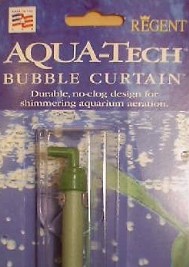
The Aqua Tech brand "bubble
curtain" or equivalent are the only bubble device I'd
recommend for bubble cloning. They are the least
restrictive to pump air thru, and because of their
hollow tubular design they produce a very uniform bubble
coverage thruout the entire length of the wand.
Cut the bubble curtains to fit the length of
the tub.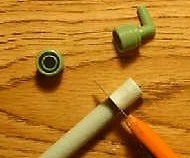
Remove the end cap
and cut the wand to length using a sharp box cutter or
razor blade knife. Replace endcaps.
One wand or two ?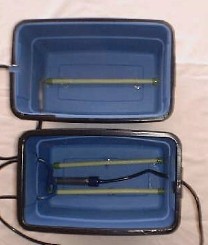
The cheapo works great with
one wand or two. For this project lets use two wands.
Note picture also shows the location of the little
heater installed. Use a dab of goop on the heaters
suction cup to hold it in place between the wands.
Glue in the wand holding clips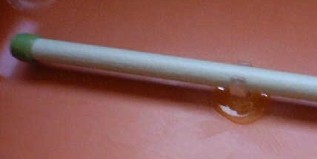
The suction cups provided with the bubble curtains
are prone to failure, when the cups stop sticking the
air wand floats to the surface and the bubbling action
stops working, causing failed clones.
Pull the
clips out of the suction cups and glue them in place
using the Goop plumbers adhesive to the bottom of the
tub. You should rough up the gluing surface by
scratching it with a knife or coarse sandpaper for a
better grip.
Allow the glue to dry for at least
two days to be sure its fully cured.
The
waterline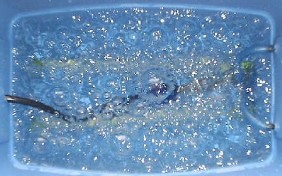
The rubbermaid one
gallon tub has a ridge molded in about 2-1/2" from the
top. This will be the waterline.
For a nice
sanitary assembly, punch two dripline couplers thru
about a 1/4" above the ridge for the airlines to exit
the tub.
Spray on the plasti dip
black rubber coating...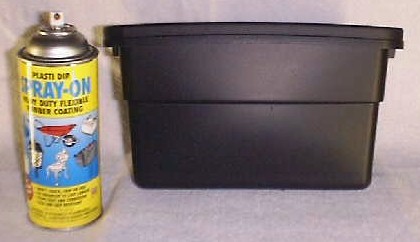
The tub needs to be coated to prevent
light from penetrating the tub and slowing down the
rooting process. Normal spray paint does not stick and
is too light transparent. The plasti dip sticks to the
rubbermaid very well and with two or three coats fairly
thick and very light proof. Spray and dry in a very well
ventilated area.
You can get away with a few
layers of duct tape, or a layer of "anti-corrosion pipe
wrapping tape". But, the Plasti-Dip I've found to be the
best solution for light proofing and neatness.
Drill the lid for the clone support
tubes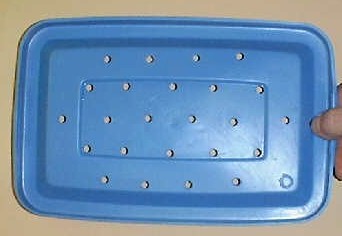
underside of lid to
show hole pattern used
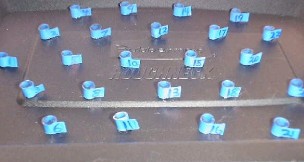
For small clones, the 1/4"
o.d. x .170 i.d. flexible drip line works fine for
support tubes, but rooted clones can be tricky to remove
from small the lid holes. Note tape tabs to keep the
smaller supports from falling thru the lid, and
numbering to identify the clones.
Optional larger support tube holes
(recommended).
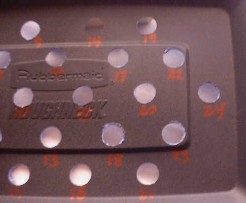
Using the 1/2" tubing for support tubes makes it
much easier to remove the rooted clones from the lid.
Number the holes to identify the clones later on. With
either size holes, the *support tubes are cut to a
maximum length of 1/2" and split down one side to be
able to remove the rooted clones.
*It is
important to have the support tubes cut short (@ 1/2"
max). The original plans had longer tubes which caused
problems on some cuttings.
You're all done
building your Cheapo-Aero cloner
Happy
cloning,
10k
Other helpful aero cloning
faqs...
Testing bubble mist cloners for adequate
mist coverage
Prepairing new cuttings for aero
cloning
Transplanting aero clones to soil